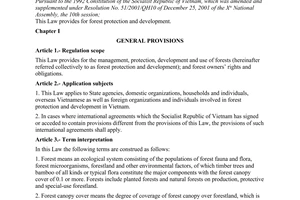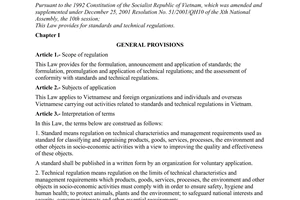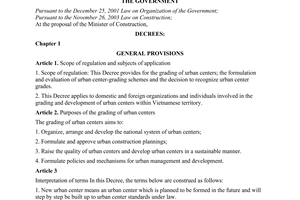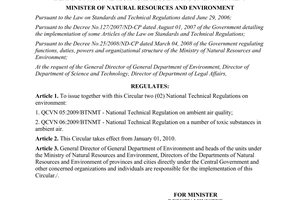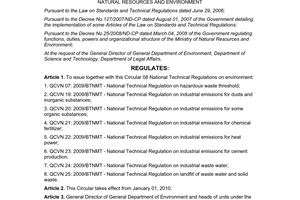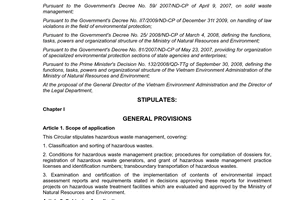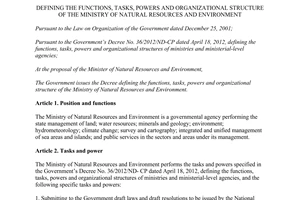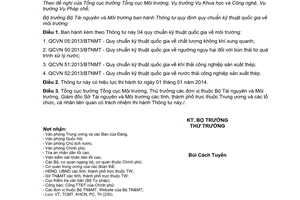Nội dung toàn văn Circular No. 32/2013/TT-BTNMT promulgation of national technical regulations on environment
|
MINISTRY OF NATURAL RESOURCES AND ENVIRONMENT |
SOCIALIST REPUBLIC
OF VIETNAM |
|
No. 32/2013/TT-BTNMT |
Hanoi, October 25, 2013 |
CIRCULAR
PROMULGATION OF NATIONAL TECHNICAL REGULATIONS ON ENVIRONMENT
Pursuant to the Law on Technical regulations and standards dated June 29, 2006;
Pursuant to the Government's Decree No. 127/2007/NĐ-CP dated August 01, 2007 on guidelines for the Law on Technical regulations and standards;
Pursuant to the Government's Decree No. 21/2013/NĐ-CP dated March 04, 2013 defining the functions, tasks, entitlements and organizational structure of the Ministry of Natural Resources and Environment;
At the request of the Director of Vietnam Environment Administration, the Heads of Science & Technology Department and Legal Department;
The Minister of Natural Resources and Environment promulgates a Circular on promulgation of National Technical Regulations on environments:
Article 1. 04 National Technical Regulations on environment are promulgated together with this Circular:
1. QCVN 05:2013/BTNMT - National Technical Regulation on Ambient Air Quality;
2. QCVN 50:2013/BTNMT – National Technical Regulation on Hazardous Thresholds for Sludge from Water Treatment Process;
3. QCVN 51:2013/BTNMT - National Technical Regulation on Emission for Steel Industry;
4. QCVN 52:2013/BTNMT - National Technical Regulation on Wastewater of Steel Industry.
Article 2. This Circular takes effect on January 01, 2014.
Article 3. Director of Vietnam Environment Administration, heads of units affiliated to the Ministry of Natural Resources and Environment, Directors of Services of Natural Resources and Environment, and relevant entities are responsible for the implementation of this Circular./.
|
|
PP MINISTER |
QCVN 05:2013/BTNMT
NATIONAL TECHNICAL REGULATION ON AMBIENT AIR QUALITY
Foreword
QCVN 05:2013/BTNMT is compiled by the drafting board of Vietnam Environment Administration, submitted by Science & Technology Department and Legal Department, and promulgated together with the Circular No. 32/2013/TT-BTNMT dated October 25, 2013 of the Minister of Natural Resources and Environment.
NATIONAL TECHNICAL REGULATION ON AMBIENT AIR QUALITY
1. GENERAL PROVISIONS
1.1. Scope of application
1.1.1. This Regulation deals with limitations on values of basic factors including sulfur dioxide (SO2), carbon monoxide (CO), dioxide nitrogen (NO2), ozone (O3), total suspended particles (TSP), 10 PM10, PM2,5 particles, and lead (Pb) in ambient air.
1.1.2. This Regulation applies to supervision and assessment of ambient air quality.
1.1.3. This Regulation does not apply to air within manufacturing facilities and indoor air.
1.2. Interpretation of terms
In this Regulation, the terms below are construed as follows:
1.2.1. Total suspended particles means total amount of particles of which the aerodynamic diameter is ≤ 100 mm.
1.2.2. Total PM10 means total amount of suspended particulate matters of which the aerodynamic diameter is ≤ 10 mm.
1.2.3. Total PM2,5 means total amount of suspended particulate matters of which the aerodynamic diameter is ≤ 2.5 mm.
1.2.4. Average value per hour means the average value of the values measured over an hour.
1.2.5. Average value per hour means the average value of the values measured over an hour.
1.2.6. Average value per 24 hours means the average value of the values measured over 24 consecutive hours.
1.2.7. Average value per year means the average value of the values measured over a year.
2. Technical regulations
Limitations on basic factors of ambient air are provided in Table 1
Table 1: Limitations on basic factors of ambient air
Unit: microgram per cube meter (mg/m3)
|
No. |
Factor |
Average value |
Average
value |
Average
value |
Average
value |
|
1 |
SO2 |
350 |
- |
125 |
50 |
|
2 |
CO |
30.000 |
10.000 |
- |
- |
|
3 |
NO2 |
200 |
- |
100 |
40 |
|
4 |
O3 |
200 |
120 |
- |
- |
|
5 |
TSP |
300 |
- |
200 |
100 |
|
6 |
PM10 |
- |
- |
150 |
50 |
|
7 |
PM2,5 |
- |
- |
50 |
25 |
|
8 |
Lead |
- |
- |
1.5 |
0.5 |
|
Notes: “-“ means not regulated |
|||||
3. DETERMINATION METHODS
3.1. Methods for analysis and determination of air quality factors are provided in the documents below:
- TCVN 5978:1995 (ISO 4221:1980). Air quality -- Determination of mass concentration of sulphur dioxide in ambient air -- Thorin spectrophotometric method.
- TCVN 5971:1995 (ISO 6767:1990). Ambient air — Determination of the mass concentration of sulfur dioxide — Tetrachloromercurate (TCM)/pararosaniline method.
- TCVN 7726:2007 (ISO 10498:2004). Ambient air -- Determination of sulfur dioxide -- Ultraviolet fluorescence method.
- TCVN 5972:1995 (ISO 8186:1989). Ambient air -- Determination of the mass concentration of carbon monoxide -- Gas chromatographic method.
- TCVN 7725:2007 (ISO 4224:2000). Ambient air -- Determination of carbon monoxide -- Non-dispersive infrared spectrometric method.
- TCVN 5067:1995. Air quality. Weight method for determination of suspended dusts content.
- TCVN 9469:2012. Air quality - Ambient air - Measurement of the mass of particulate matter on a filter medium - Beta-ray absorption method
- AS/NZS 3580.9.6:2003. Methods for sampling and analysis of ambient air - Determination of suspended particulate matter - PM10 high volume sampler with size-selective inlet - Gravimetric method.
- AS/NZS 3580.9.7:2009. Methods for sampling and analysis of ambient air - Determination of suspended particulate matter - Dichotomous sampler (PM10, coarse PM and PM2,5) - Gravimetric method.
- TCVN 6137:2009 (ISO 6768:1998). Ambient air — Determination of mass concentration of nitrogen dioxide — Modified Griess-Saltzman method.
- TCVN 7171:2002 (ISO 13964:1998). Air quality -- Determination of ozone in ambient air -- Ultraviolet photometric method.
- TCVN 6157:1996 (ISO 10313:1993). Ambient air -- Determination of the mass concentration of ozone -- Chemiluminescence method
- TCVN 6152:1996 (ISO 9855:1993). Ambient air -- Determination of the particulate lead content of aerosols collected on filters -- Atomic absorption spectrometric method.
3.2. The methods provided in National Standards and International Standards with equivalent or higher accuracies than those mentioned in 3.1 are accepted.
4. IMPLEMENTATION
4.1. This Regulation replaces QCVN 05:2009/BTNMT – National Technical Regulation on Ambient air quality promulgated together with Circular No. 16/2009/TT-BTNMT dated October 17, 2009 of the Minister of Natural Resources and Environment.
4.2. Environment authorities are responsible for providing guidance and inspect the implementation of this Regulation.
4.3. Where the analysis methods provided in this Regulation are revised, the newest ones shall apply.
QCVN 50:2013/BTNMT
NATIONAL TECHNICAL REGULATION ON HAZARDOUS THRESHOLDS FOR SLUDGE FROM WATER TREATMENT PROCESS
Foreword
QCVN 50:2013/BTNMT is based on QCVN 07:2009/BTNMT on hazardous thresholds for wastes, submitted by Vietnam Environment Administration, Science & Technology Department and Legal Department, and promulgated together with the Circular No. 32/2013/TT-BTNMT dated October 25, 2013 of the Minister of Natural Resources and Environment
NATIONAL TECHNICAL REGULATION ON HAZARDOUS THRESHOLDS FOR SLUDGE FROM WATER TREATMENT PROCESS
1. GENERAL PROVISIONS
1.1. Scope
This Regulation deals with hazardous thresholds of factors (except for radioactive factors) in sludge produced during sewage treatment process and supplied water treatment process (hereinafter referred to as water treatment process), which is the basis for sludge classification and management.
This Regulation applies to sludge produced during water treatment processes that are enumerated in Circular No. 12/2011/TT-BTNMT dated April 14, 2011 of the Ministry of Natural Resources and Environment on hazardous waste management.
1.2. Regulated entities
This Regulation applies to every entity engaged in the activities related to sludge produced during water treatment process.
1.3. Interpretation of terms
In this Regulation, the terms below are construed as follows:
1.3.1. Sludge produced during water treatment process means a mixture of solids that are separated, deposited, and discharged during water treatment process.
1.3.2. Absolute level means the level of sludge factors expressed in parts per minute (ppm).
1.3.3. Absolute threshold (Htc) means the hazardous threshold of sludge according to absolute level.
1.3.3. Basic absolute level (H) means value used for calculating absolute threshold (Htc) according to (1).
1.3.5. Eluate/leaching concentration means the concentration (mg/l) of the factor in the solution after analyzing the sludge samples by leaching Ctc means the hazardous threshold of factors in sludge according to leaching concentration.
1.3.6. CAS means the code of chemicals according to (Chemical Abstracts Services).
2. Technical regulations
2.1. General principles
Whether a stream of sludge is classified as hazardous waste depends on the hazardous thresholds of its factors. If the sludge sample analysis result shows that at least 01 of the factors exceeds the hazardous thresholds at any sampling time, the stream of sludge is classified as hazardous waste.
2.2. Classification of sludge
Sludge produced during water treatment process is classified as hazardous waste in one of the following cases:
a) pH ≥ 12.5 or pH ≤ 2.0;
b) The value of at least 01 factor in Table 1 exceeds both Htc and Ctc.
2.3. Absolute threshold Htc
Absolute threshold (Htc, ppm) is calculated as follows:
![]() (1)
(1)
Where:
+ H (ppm): the absolute level provided for in Table 1;
+ T: the ratio of dry solid in the sludge sample to total weight of the sludge sample.
2.4. Hazardous threshold according to leaching concentration Ctc
Hazardous thresholds according to leaching concentrations of factors in sludge are provided in Table 1
Table 1. Absolute level (H) and hazardous thresholds according to leaching concentration of factors in sludge
|
No. |
Factor |
CAS number |
Chemical formula |
Basic absolute level H (ppm) |
Hazardous threshold according to leaching concentration Ctc (mg/l) |
|
1 |
Arsenic |
- |
As |
40 |
2 |
|
2 |
Barium |
- |
Ba |
2,000 |
100 |
|
3 |
Silver |
- |
Ag |
100 |
5 |
|
4 |
Cadmium |
- |
Cd |
10 |
0.5 |
|
5 |
Lead |
- |
Pb |
300 |
15 |
|
6 |
Cobalt |
- |
Co |
1,600 |
80 |
|
7 |
Zinc |
- |
Zn |
5,000 |
250 |
|
8 |
Nickel |
- |
Ni |
1,400 |
70 |
|
9 |
Selenium |
- |
Se |
20 |
1 |
|
10 |
Mercury |
- |
Hg |
4 |
0.2 |
|
11 |
Chromium VI |
- |
Cr6+ |
100 |
5 |
|
12 |
Total cyanide |
- |
CN- |
590 |
- |
|
13 |
Total oil |
- |
- |
1,000 |
50 |
|
14 |
Phenol |
108-95-2 |
C6H5OH |
20,000 |
1,000 |
|
15 |
Benzene |
71-43-2 |
C6H6 |
10 |
0.5 |
|
16 |
Chlorobenzene |
108-90-7 |
C6H5Cl |
1,400 |
70 |
|
17 |
Toluene |
108-88-3 |
C6H5CH3 |
20,000 |
1,000 |
|
18 |
Naphthalene |
91-20-3 |
C10H8 |
1,000 |
- |
|
19 |
Chlordane |
57-74-9 |
C10H6Cl8 |
0.6 |
0.03 |
|
20 |
2,4-Diclophenoxy acetic acid (2,4-D) |
94-75-7 |
C6H3Cl2OCH2 COOH |
100 |
5 |
|
21 |
Lindane |
58-89-9 |
C6H6Cl6 |
6 |
0,3 |
|
22 |
Methoxychlor |
72-43-5 |
C16H15CI3O |
200 |
10 |
|
23 |
Endrin |
72-20-8 |
C12H8Cl6O |
0.4 |
0.02 |
|
24 |
Heptachlor |
76-44-8 |
C10H5Cl7 |
0.2 |
0.01 |
|
25 |
Methyl parathion |
298-00-0 |
(CH3O)2PSO-C6H4NO2 |
20 |
1 |
|
26 |
Parathion |
56-38-2 |
C10H14NO5PS |
400 |
20 |
- The factors No. 1 thru 15 shall apply to all kinds of sludge from water treatment processes.
- The factors No. 1 thru 18 shall apply to sludge from water treatment processes or special manufacturing processes listed in Table 2.
- All factors in Table 1 (No. 1 thru 26) shall apply to sludge from water treatment processes of the manufacturing, processing, supply of pesticides, timber preservation agents, and other organic biocides (No. 10 in Table 2).
Table 2. Sludge from special manufacturing process
|
No. |
Sludge from water treatment process of special manufacturing process |
Hazardous waste code (according to Circular No. 12/2011/TT-BTNMT dated April 14, 2011) |
|
1 |
Sludge from water treatment process of oil refining |
01 04 07 |
|
2 |
Sludge from water treatment process of oil recycling and oil exploitation |
12 07 05 |
|
3 |
Sludge from water treatment process of manufacturing, supply and use of synthetic rubber and artificial threads. |
03 02 08 |
|
4 |
Sludge from water treatment process of medicine manufacturing and supply process |
03 05 08 |
|
5 |
Sludge from water treatment process of manufacturing, supply, and use of fat, soap, detergent, antiseptic, and cosmetics |
03 06 08 |
|
6 |
Sludge from water treatment process of manufacturing, supply, and use of pure chemicals and other chemical products |
03 07 08 |
|
7 |
Sludge from water treatment process of manufacturing of glass and glass products |
06 01 06 |
|
8 |
Sludge from water treatment process of textile and dyeing industries |
10 02 03 |
|
9 |
Sludge from water treatment process of manufacturing, supply, and use of organic colorings |
03 03 08 |
|
10 |
Sludge from water treatment processes of the manufacturing, processing, supply of pesticides, timber preservation agents, and other organic biocides |
03 04 08 |
|
11 |
Sludge from water treatment process at the facilities manufacturing, supplying, and using inorganic chemicals |
02 05 01 |
|
12 |
Sludge from water treatment process of manufacturing, supply, and use of basic organic chemicals |
03 01 08 |
3. SAMPLING, ANALYSIS, AND CLASSIFICATION OF SLUDGE
3.1. Sampling and analysis
3.1.1. The sampling and analyzing unit must have the certificate of eligibility to provide environmental monitoring services or appointed by an environment authority.
3.1.2. The sampling and analyzing unit is obliged to:
a) Take legal responsibility for the sampling and analysis result, which is the basis for classification and management of sludge.
b) Appoint qualified employees to take samples and make sampling records.
c) Apply the sampling principles and determination methods provided for in this Regulation.
3.1.3. Where there are discrepancies between the analysis results given by two units, the environment authority shall appoint a third unit, which also satisfies all requirements in 3.1.1) as the adjudicator, and request both units to reperform the sampling and analysis for comparison purposes.
3.2. Sampling, analysis, and classification of sludge
Samples must be taken on 03 different days, the sampling time on each day must be different (beginning, middle, or end of a shift or a batch).
Sludge must be well stirred before being sampled; At least 03 samples at 03 random positions shall be taken.
The mean value of analysis results shall be compared to the absolute threshold Htc or hazardous threshold according to leaching concentration Ctc to classify sludge
4. DETERMINATION METHODS
4.1. Sludge shall be sampled in accordance with instructions in the following national standards:
- TCVN 6663-13:2000 - Water quality – Sampling. Part 13: Guidance on sampling of, wastewater and related sludge;
- TCVN 6663-15:2004 - Water quality – Sampling. Guidance on preservation and handling of sludge and sediment samples.
4.2. Factors in sludge shall be determined in accordance the following national and international standards:
- ASTM D4980-89: Standard test method for screening of pH in waste.
- Solid wastes - The toxicity characteristic leaching procedure.
- TCVN 9240:2012 - Standard test method for single batch extraction method for wastes.
- EPA SW-846 - Method 9010 or 9012: Determination of Cyanide in wastes.
- US EPA 9071 B - Method 9071 B n-Hecxan extractable material (HEM) for sludge, sediment, and solid samples.
4.3. Solution analysis after leaching:
Accredited national and international standards shall apply to determination of leaching concentrations of hazardous components.
5. IMPLEMENTATION
5.1. This Regulation replaces QCVN 07:2009/BTNMT – National Technical Regulation on thresholds of hazardous wastes promulgated together with Circular No. 16/2009/TT-BTNMT dated November 16, 2009 of the Minister of Natural Resources and Environment when determining hazardous thresholds of waste sludge from water treatment process.
5.2. The hazardous thresholds of the factors in this Regulation are equivalent to QCVN 07:2009/BTNMT. Where QCVN 07:2009/BTNMT is revised or replaced, hazardous thresholds shall be determined according to new regulations.
5.3. Environment authorities are responsible for providing guidance and inspect the implementation of this Regulation.
5.4. Where the determination methods provided in this Regulation are revised or replaced, the newest ones shall apply.
QCVN 51:2013/BTNMT
NATIONAL TECHNICAL REGULATION ON EMISSION FOR STEEL INDUSTRY
Foreword
QCVN 51:2013/BTNMT is compiled by the drafting board, submitted by Vietnam Environment Administration, Science & Technology Department and Legal Department, and promulgated together with the Circular No. 32/2013/TT-BTNMT dated October 25, 2013 of the Minister of Natural Resources and Environment.
NATIONAL TECHNICAL REGULATION ON EMISSION FOR STEEL INDUSTRY
1. GENERAL PROVISIONS
1.1. Scope
This Regulation deals with maximum permissible value of pollution factors in emission from steel industry discharged into the air.
1.2. Regulated entities
This Regulation applies to steel factories. Every entity related to the discharge of industrial emission from steel production into the air shall comply with this Regulation.
1.3. Interpretation of terms
In this Regulation, the terms below are construed as follows:
1.3.1. Emission from steel industry means the mixture of matters discharged into the air from chimneys of steel factories.
1.3.2. A steel factory means a factory or manufacturing facility that engages in one of the following production stages: coke production, sintering, reconstitution, cast iron production, steel tempering, and steel rolling.
1.3.3. Normative cube meter of emission means (Nm3) a cube meter of emission at 25°C in temperature and 760 mmHg in absolute pressure.
2. TECHNICAL REGULATIONS
2.1. Maximum permissible value of pollution factors in emission from steel industry
Over the normal operation, maximum permissible values of pollution factors in emission from steel industry are calculated as follows:
Cmax = C x Kp x Kv
Where:
- Cmax is the maximum permissible values of factors in emission from steel industry, expressed in mg/Nm3
- C is values of the factors in 2.2
- Kp is the coefficient of discharge rate corresponding to emission flow rate of each chimney of the steel factory specified in 2.3
- Kv is the coefficient of region which corresponds to the location of the steel factory according to 2.4.
2.2. C value
2.2.1. C value of the factors of emission from ore reconstitution, sintering, cast iron production, steel tempering, and steel rolling are provided in Table 1
Table 1 – C Value for calculating maximum permissible value of pollution factors in emission from steel industry
(not applied to coke production)
|
No. |
Factor |
Unit |
C value |
||
|
A |
B1 |
B2 |
|||
|
1 |
Total particles |
mg/Nm3 |
400 |
200 |
100 |
|
2 |
Carbon oxide, CO (*) |
mg/Nm3 |
1,000 |
1,000 |
500 |
|
3 |
Nitrous oxide, NOx (expressed in NO2) |
mg/Nm3 |
1,000 |
850 |
500 |
|
4 |
Sulphur dioxide, SO2 |
mg/Nm3 |
1,500 |
500 |
500 |
|
5 |
Cadmium and its compounds (expressed in Cd) |
mg/Nm3 |
20 |
5 |
1 |
|
6 |
Copper and its compounds (expressed in Cu) |
mg/Nm3 |
20 |
10 |
10 |
|
7 |
Lead and its compounds (expressed in Pb) |
mg/Nm3 |
10 |
5 |
2 |
|
8 |
Zinc and its compounds (expressed in Zn) |
mg/Nm3 |
30 |
30 |
20 |
|
9 |
Antimony and its compounds (expressed in Sb) |
mg/Nm3 |
20 |
10 |
10 |
|
10 |
Total volatile organic chemicals, VOC(**) |
mg/Nm3 |
|
20 |
20 |
|
11 |
Total Dioxin/Furan (expressed in TEQ)(***) |
ng/Nm3 |
|
0.6 |
0,1 |
|
(*) CO value in the table does not apply to sintering stage. CO during sintering stage shall controlled by calculating the chimney height to ensure ambient air quality; (**) Total VOC in emission is only controlled during sintering stage; (**) Total Dioxin/Furan in emission is only controlled during sintering stage and electric arc furnace stage; Reference oxygen content in emission from steel industry is 7% |
|||||
2.2.2. C values of factors in emission during coke production are provided in Table 2 below:
Table 2 – C Values for calculating maximum permissible value of pollution factors in emission during coke production
|
No. |
Factor |
Unit |
C value |
||
|
A |
B1 |
B2 |
|||
|
1 |
Total particles |
mg/Nm3 |
400 |
200 |
100 |
|
2 |
Sulphur dioxide, SO2 |
mg/Nm3 |
1,500 |
500 |
500 |
|
3 |
Nitrous oxide NOx (expressed in NO2) |
mg/Nm3 |
1,000 |
850 |
750 |
|
4 |
Cadmium and its compounds (expressed in Cd) |
mg/Nm3 |
20 |
5 |
1 |
|
5 |
Lead and its compounds (expressed in Pb) |
mg/Nm3 |
10 |
5 |
2 |
|
6 |
Total volatile organic chemicals, VOC |
mg/Nm3 |
|
20 |
20 |
|
7 |
Benzo(a)pyrene |
mg/Nm3 |
- |
0.1 |
0.1 |
|
8 |
Antimony and its compounds (expressed in NH3) |
mg/Nm3 |
76 |
50 |
30 |
|
9 |
Hydrochloric acid, HCl |
mg/Nm3 |
200 |
50 |
20 |
|
10 |
Fluorine, HF, or inorganic compounds of fluorine (expressed in HF) |
mg/Nm3 |
50 |
20 |
10 |
|
11 |
Hydrogen sulfide H2S |
mg/Nm3 |
7.5 |
7.5 |
5 |
|
Reference oxygen content in emisison from steel industry is 7% |
|||||
2.2.3. Application roadmap:
- New steel factories (whose environmental impact assessment reports and commitments to environment protection are approved after this Regulation takes effect) shall apply C values in Column B2 of Table 1 or Table 2
- The steel factories that have been operating before January 16, 2007 shall apply C values in Column A in Table 1 or Table 2 until the end of December 31, 2014. From January 01, 2015, C values in Column B1 of Table 1 or Table 2 shall apply.
- Other factories shall apply C values in Column B1 of Table 1 or Table 2.
- Values of Benzo(a)pyrene and VOC shall apply from January 01, 2015.
- Values of Dioxin/Furan shall apply from January 01, 2017.
2.3. Coefficient of discharge rate Kp
Coefficients of discharge rate Kp are provided for in Table 3 below:
Table 3: Coefficient of discharge rate Kp of each chimney
|
Discharge rate (m3/h) |
Kp |
|
P ≤ 20,000 |
1 |
|
20,000 <>P ≤ 100,000 |
0.9 |
|
P > 100,000 |
0.8 |
Discharge rate P is the highest discharge rate of each chimney in the environmental impact assessment report, commitment to environment protection, environmental protection scheme, or Certificate of environmental protection works and measures which is approved by a competent authority.
If the discharge rate P is changed and thus no longer correspond to coefficient Kp being applied, the steel factory must notify the competent authority to adjust Kp.
2.4. Coefficient of region Kv
Coefficients of region Kv are provided for in Table 4:
Table 4. Coefficient of region Kv
|
Region |
Kv |
|
|
Region 1 |
Special Class urban areas (1) và Class I urban areas (1); specialized forests (2); rated natural heritage, historic and cultural sites (3); or the areas below 02 km away from the boundaries of the said areas. |
0.6 |
|
Region 2 |
Class II, III, and IV urban areas (1) and the areas below 02 km away from the boundaries of the said areas; suburban areas of Special Class areas and Class I areas, the distance of which from the boundaries of urban areas are ≥ 02 km and ≤06 km. |
0.8 |
|
Region 3 |
Industrial parks, Class V urban areas (1); suburban areas of Class II, III, and IV urban areas, the distance of which from the boundaries of urban areas are ≥ 02 km; the areas that are ≤ 02 km from the boundaries of the said areas (4) |
1.0 |
|
Region 4 |
Urban areas |
1.2 |
|
Region 5 |
Urban areas on highlands |
1.4 |
|
Notes (1) Urban areas are determined according to Decree No. 42/2009/NĐ-CP dated May 07, 2009 on classification of urban areas; (2) Specialized forests according to the Law on Forest protection and development dated December 14, 2004 include: national parks, sanctuaries, landscape protection zones, forests serving scientific research and experiments; (3) Natural heritage, historical and cultural sites established and rated by UNESCO, the Prime Minister, or regulatory bodies; (4) If the distance from emission source to 02 areas or more is smaller than 02 km, the smallest coefficient of region shall apply; (5) The distance mentioned in Table 4 is from the emission source. |
||
3. DETERMINATION METHODS
3.1. Methods for sampling and determination of factors in emission from steel industry are provided in the standards below:
|
No. |
Factor |
Method and standard number |
|
1 |
Determination of sampling position |
- EPA 1 - Sample and velocity traverses for stationary sources |
|
2 |
Velocity and flow rate |
- EPA 2 - Determination of stack gas velocity and volumetric flow rate |
|
3 |
Dry molecular weight |
- EPA 3 - Gas analysis for the determination of dry molecular weight |
|
4 |
Gas moisture |
- EPA 4 - Determination of moisture content in stack gases |
|
5 |
Total particles |
- TCVN 5977:2009 - Stationary source emissions – Manual determination of mass concentration of particulate matter; - EPA 5 - Determination of particulate matter emissions from stationary sources. |
|
6 |
Sulphur dioxide, SO2 |
- TCVN 6750:2000 - Stationary source emissions - Determination of mass concentration of sulfur dioxide - Ion chromatography method; - EPA 6 - Determination of sulfur dioxide emissions from stationary sources. |
|
7 |
Nitrous oxide, NoX |
- TCVN 7172:2002 - Stationary source emissions – Determination of the mass concentration of nitrogen oxides – Naphthylethylenediamine photometric method; - EPA 7 - Determination of nitrogen oxide emissions from stationary sources |
|
8 |
Carbon oxide, CO |
- TCVN 7242:2003 - Medical solid waste incinerators - Determination method of carbon monoxide (CO) concentration in fluegas - EPA 10 - Determination of carbon monoxide emissions from stationary sources. |
|
9 |
Cadmium and its compounds |
- TCVN 7557-1:2005 - Medical solid waste incinerators – Determination of heavy metals in fluegas – Part 1: General requirements; - TCVN 7557-3:2005 - Medical solid waste incinerators - Determination of heavy metals in fluegas -Part 3: Determination of cadmium and lead concentrations by flame and electrothermal atomic absorption spectrometric method; - EPA 29 - Determination of metals emissions from stationary sources. - EPA 12 - Determination of inorganic lead emissions from stationary sources |
|
10 |
Copper and its compounds |
|
|
11 |
Lead and its compounds |
|
|
12 |
Zinc and its compounds |
|
|
13 |
Antimony and its compounds |
|
|
14 |
Benzo(a)pyrene |
California EPA Method 429 - Determination of Polycyclic Aromatic Hydrocarbon (PAH) Emissions from Stationary Sources, |
|
15 |
Ammonia and ammonium compounds |
South Coast Air Quality Management District Method 207.1 - Determination of Amonia Emissions from Statitionary Sources. |
|
16 |
Hydrochloric acid, HCl |
- TCVN 7244:2003 – Medical solid waste incinerators - Determination method of hydrochloric acid (HCl) concentration in fluegas; - EPA 26 - Determination of Hydrogen Chloride Emissions From Stationary Sources. |
|
17 |
Fluorine, HF, or inorganic compounds of fluorine |
- TCVN 7243:2003 - Medical solid waste incinerators - Determination method of hydrofloride acid (HF) concentration in fluegas; Method 13A - Determination of total fluoride emissions from stationary sources - SPADNS zirconium Lake method. Method 13B - Determination of total fluoride emissions from stationary sources - Specific ion electrode method. |
|
18 |
Hydrogen sulfide H2S |
EPA 15 - Determination of hydrogen sulfide, carbonyl sulfide, and carbon disulfide emissions from stationary sources. |
|
19 |
Total Dioxin/Furan |
- TCVN 7556-1:2005 – Medical solid waste incinerators – Determination of PCDD/PCDF concentration. Part 1: Sampling. - TCVN 7556-2:2005 – Medical solid waste incinerators – Determination of PCDD/PCDF concentration. Part 2: Leaching and cleaning. - TCVN 7556-3:2005 – Medical solid waste incinerators – Determination of PCDD/PCDF concentration. Part 3: Quantitative and qualitative analysis.. - EPA 23 - Determination of Polychlorinated Dibenzo-p-Dioxins and Polychlorinated Dibenzofurans From Stationary Sources |
|
20 |
Total volatile organic chemicals, VOC |
- EPA 18 - Measurement of gaseous organic compound emissions by gas chromatography |
|
21 |
Measuring with hand-operated equipment |
- TCVN 5976:1995 - Stationary source emission - Determination of the mass concentration of sulfur dioxide (SO2) - Performance characteristics of automated measuring methods |
3.2. The methods provided in National Standards and International Standards with equivalent or higher accuracies than those mentioned in 3.1 are accepted.
4. IMPLEMENTATION
4.1. Environment authorities are responsible for providing guidance and inspect the implementation of this Regulation.
4.2. Where the standards cited in 3.1 are revised or replaced, the newest ones shall apply.
QCVN 52:2013/BTNMT
NATIONAL TECHNICAL REGULATION ON WASTEWATER OF STEEL INDUSTRY
Foreword
QCVN 52:2013/BTNMT is compiled by the drafting board, submitted by Vietnam Environment Administration, Science & Technology Department and Legal Department, and promulgated together with the Circular No. 32/2013/TT-BTNMT dated October 25, 2013 of the Minister of Natural Resources and Environment.
NATIONAL TECHNICAL REGULATION ON WASTEWATER OF STEEL INDUSTRY
1. GENERAL PROVISIONS
1.1. Scope
This Regulation deals with maximum permissible value of pollution factors in wastewater from steel industry discharged into receiving waters.
1.2. Regulated entities
1.2.1. This Regulation applies to wastewater from steel industry. Every entity related to the discharge of wastewater from steel industry into the receiving waters shall comply with this Regulation.
1.2.2. Regulations of centralized wastewater treatment plants shall apply to wastewater from steel industry discharged into collection systems of centralized wastewater treatment plants.
1.3. Interpretation of terms
In this Regulation, the terms below are construed as follows:
1.3.1. Wastewater from steel industry means wastewater produced during the operation of steel factories.
1.3.2. A steel factory means a factory or manufacturing facility that engages in one of the following production stages: coke production, sintering, reconstitution, cast iron production, steel refining, and steel rolling.
1.3.3. Receiving waters include: drainage systems of urban areas and residential areas; rivers, streams, canals, channels, ditches; lakes, ponds, swamps, coastal waters with certain purposes.
2. TECHNICAL REGULATIONS
2.1. Maximum permissible value of pollution factors in wastewater from steel industry discharged into receiving waters
2.1.1. Maximum permissible value of pollution factors in wastewater from steel industry discharged into receiving waters is calculated as follows:
Cmax = C x Kq x Kf
Where:
- Cmax : Maximum permissible value of pollution factors in wastewater from steel industry discharged into receiving waters.
- C: value of pollution factors in emission from steel industry according to 2.2;
- Kq: the coefficient of the receiving waters according to 2.3, which corresponds to flow rate of the river, stream, canal, channel, ditche, or volume of the lake, pond, swamp, or purpose of the coastal waters.
- Kf : coefficient of discharge rate according to 2.4, which corresponds to the total discharge rate of steel factories;
2.1.2. With regard to temperature and pH, Cmax = C (Kq and Kf are not applied)
2.1.3. If wastewater from steel industry is discharged into the drainage system of an urban area or residential area without a centralized wastewater treatment plant, then Cmax = C in column B Table 1.
2.2. C values of pollution factors in wastewater from steel industry are provided in Table 1
Table 1. C values of pollution factors in wastewater from steel industry, which are the basis for calculating maximum permissible value
|
No. |
Factor |
Unit |
C value |
|
|
A |
B |
|||
|
1 |
Temperature |
°C |
40 |
40 |
|
2 |
pH |
- |
6 đến 9 |
5.5 đến 9 |
|
3 |
BOD5 (20°C) |
mg/l |
30 |
50 |
|
4 |
COD |
mg/l |
75 |
150 |
|
5 |
Suspended solids |
mg/l |
50 |
100 |
|
6 |
Total mineral oil |
mg/l |
5 |
10 |
|
7 |
Total phenol |
mg/l |
0.1 |
0.5 |
|
8 |
Total cyanide |
mg/l |
0.1 |
0.5 |
|
9 |
Total nitrogen |
mg/l |
20 |
60 |
|
10 |
Total mercury |
mg/l |
0.005 |
0.01 |
|
11 |
Cadmium |
mg/l |
0.05 |
0.1 |
|
12 |
Chromium (VI) |
mg/l |
0.05 |
0.5 |
Column A in Table 1 provides the C values of pollution factors in wastewater from steel industry discharged into the water sources used for tap water supply;
Column B in Table 1 provides the C values of pollution factors in wastewater from steel industry discharged into the water sources that are not used for tap water supply;
The purpose of receiving waters is determined where wastewater is discharged.
2.3. Coefficient Kq of receiving waters
Flow rate coefficient Kq of rivers, streams, canals, channels, ditches are provided in Table 2 below:
Table 2: Flow rate coefficients Kq of receiving waters
|
Flow rate of receiving waters (Q) Unit: (m3/s) |
Kq |
|
Q ≤ 50 |
0.9 |
|
50 < q="">≤ 200 |
1 |
|
200 < q="">≤ 500 |
1.1 |
|
Q > 500 |
1.2 |
Q is calculated according to mean value of flow rates of the receiving waters in 03 driest months in 03 consecutive years (according to a meteorology and hydrology agency).
2.3.2. Coefficients Kq of volume of ponds, lakes, swamps are provided in Table 3 below:
Table 3: Coefficients Kq of volume of receiving waters
|
Volume of receiving waters (V) Unit: (m3) |
Kq |
|
V ≤ 10 x 106 |
0.6 |
|
10 x 106 < v=""> 100 x 106 |
0.8 |
|
V > 100 x 106 |
1.0 |
V is calculated according to mean value of volume of the receiving waters in 03 driest months in 03 consecutive years (according to a meteorology and hydrology agency).
2.3.3. If there is no information about the flow rate of the river, stream, canal, channel, or ditch, then Kq = 0.9. If there is no information about the volume of the lake, pond, swamp, then Kq = 0.6.
2.3.4. Coefficient Kq of receiving waters being coastal waters, coastal saltwater and brackish water lagoons.
Kq = 1 shall apply to coastal seawaters used for marine life protection, water sports and entertainment, saltwater and brackish water lagoons.
Kq = 1.3 shall apply to coastal seawaters that are not used for marine life protection, water sports and entertainiment.
2.4. Discharge rate coefficient Kf
Discharge rate coefficient Kf are provided in Table 4 below:
Table 4: Discharge rate coefficient Kf
|
Discharge Rate (F) Unit: m3/24h |
Kf |
|
F ≤ 50 |
1.2 |
|
50 < f="">≤ 500 |
1.1 |
|
500 < f="">≤ 5,000 |
1.0 |
|
F > 5,000 |
0.9 |
Discharge rate F is calculated according to the highest discharge rate in the environmental impact assessment, commitment to environment protection, environmental protection scheme, or certificate of environmental protection completions and environmental protection tasks approved by a competent authority.
If the discharge rate no longer corresponds to the coefficient Kf applied, the steel factory must request the competent authority to adjust coefficient Kf.
3. DETERMINATION METHODS
3.1. Methods for sampling and determination of factors in wastewater from steel industry are provided in the standards below:
|
No. |
Factor |
Method and standard number |
|
1 |
Sampling |
- TCVN 6663-1:2011 (ISO 5667-1:2006) - Water quality -- Sampling -- Part 1: Guidance on the design of sampling programmes and sampling techniques; - TCVN 6663-3:2008 (ISO 5667-3:2003) - Water quality -- Sampling. Guidance on the preservation and handling of water samples; - TCVN 5999:1995 (ISO 5667-10:1992) - Water quality – Sampling. Guidance on sampling of waste waters. |
|
2 |
Temperature |
- TCVN 4557:1998. Waste water - Method for dertermination of the temperature; |
|
3 |
pH |
- TCVN 6492:2011 (ISO 10523:2008). water quality -- Determination pH; |
|
4 |
BOD5 (20°C) |
- TCVN 6001-1:2008 (ISO 5815-1:2003), Water quality -- Determination of biochemical oxygen demand after n days (BODn) -- Part 1: Dilution and seeding method with allylthiourea addition; - TCVN 6001-2:2008 (ISO 5815-2:2003), Water quality -- Determination of biochemical oxygen demand after n days (BODn) -- Part 2: Method for undiluted samples; - APHA 5210 B - Determination of BOD |
|
5 |
COD |
- TCVN 6491:1999 (ISO 6060:1989) Water quality - Determination of chemical oxygen demand; - APHA 5220 - Determination of COD |
|
6 |
Suspended solids |
- TCVN 6625:2000 (ISO 11923:1997). Water quality -- Determination of suspended solids by filtration through glass-fibre filters; - APHA 2540 - Determination of suspended solids |
|
7 |
Total mineral oil |
- TCVN 5070:1995. Water quality - Weight method for determination of oil and oil product. - TCVN 7875:2008 - Water - Determination of oil and grease - Partition-infrared method; - APHA 5520 - Determination of total mineral oil |
|
8 |
Total phenol |
- TCVN 6216:1996 (ISO 6439:1990) - Water quality -- Determination of phenol index -- 4-Aminoantipyrine spectrometric methods after distillation; - TCVN 6199-1:1995 (ISO 8165/1:1992) Water quality — Determination of selected monovalent phenols — Part 1: Gas-chromatographic method after enrichment by extraction; - APHA 5530 - Determination of phenol |
|
9 |
Total cyanide |
- TCVN 6181:1996 (ISO 6703-1:1984) Water quality – Determination of total cyanide; - APHA 4500-CN- - Determination of cyanide |
|
10 |
Total nitrogen |
- TCVN 6638:2000 Water quality – Determination of nitrogen - catalytic digestion after reduction with devarda alloy; - APHA 4500-N.C và 4500-NO3-.E – Determination of nitrogen |
|
11 |
Total mercury |
- TCVN 7877:2008 (ISO 5666:1999) Water quality – Determination of Mercury; - APHA 3500-Hg - Determination of Mercury |
|
12 |
Cadmium |
- TCVN 6193:1996 Water quality - Determination of cobalt nickel, copper, zinc, cadmium, and lead Flame atomic absorption spectrometric methods; - TCVN 6665:2011 (ISO 11885:2007) Water quality - Determination of selected elements by inductively coupled plasma optical emission spectrometry (ICP-OES); - APHA 3500-Cd - Determination of cadmium |
|
13 |
Chromium (VI) |
- TCVN 6658:2000 Water quality - Determination of chromium (VI) - Spectrometric method using 1,5-diphenylcarbazide; - TCVN 6665:2011 (ISO 11885:2007) Water quality - Determination of selected elements by inductively coupled plasma optical emission spectrometry (ICP-OES); - APHA 3500-Cr.B - Determination of Chromium |
3.2. The methods provided in National Standards and International Standards with equivalent or higher accuracies than those mentioned in 3.1 are accepted.
4. IMPLEMENTATION
4.1. Environment authorities are responsible for providing guidance and inspect the implementation of this Regulation.
4.2. Where the standards cited in 3.1 are revised or replaced, the newest ones shall apply.
